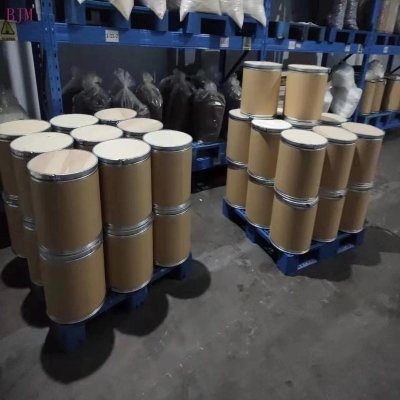-
Categories
-
Pharmaceutical Intermediates
-
Active Pharmaceutical Ingredients
-
Food Additives
- Industrial Coatings
- Agrochemicals
- Dyes and Pigments
- Surfactant
- Flavors and Fragrances
- Chemical Reagents
- Catalyst and Auxiliary
- Natural Products
- Inorganic Chemistry
-
Organic Chemistry
-
Biochemical Engineering
- Analytical Chemistry
- Cosmetic Ingredient
-
Pharmaceutical Intermediates
Promotion
ECHEMI Mall
Wholesale
Weekly Price
Exhibition
News
-
Trade Service
Tetrazolinone herbicide tetrazolin for paddy fields was discovered by Nihon Bayer Agrochem K.
K.
in 1992 and mainly developed by Bayer AG
.
The herbicide is mainly used for the control of weeds in rice fields.
It has good activity on gramineous weeds and annual Cyperaceae weeds in rice fields, and has excellent control effects on barnyardgrass.
It is used in the three-leaf stage of rice before or after emergence.
Safe before use
.
Tetrafenacet was listed around 2000.
In 2013, Bayer had sales of 70 million U.
S.
dollars and 2015 sales of 50 million U.
S.
dollars.
The compound annual growth rate from 2010 to 2015 was 4.
6%, and the sales growth rate was relatively slow
.
At present, the herbicide is still in a blank state in China.
In 2000, Bayer temporarily registered Tetrafentrazone technical and 50% Tetrafenacet wettable powder in China.
However, the temporary registration has expired
.
Japan's Bayer Agrochemicals Co.
, Ltd.
applied for the compound, preparation, and use patent CN1045958C of tetrazolin in China, the patent name is "tetrazolinone compound and its preparation method, herbicidal composition containing it and its use as a herbicide The application date was February 25, 1994.
The patentee was Bayer Pesticide Co.
, Ltd.
Japan.
The current patent protection period has expired
.
Tetrazolam English common name fentrazamide, chemical name 4-[2-chlorophenyl]-N-cyclohexyl-N-ethyl-4,5-dihydro-5-oxy-1H-tetrazole-1- Amide, development code YRC2388, BAY YRC 2388 (Bayer), NBA 061, CAS accession number 158237-07-1, molecular formula C16H20ClN5O2, molecular weight 349.
8
.
Appearance of colorless crystals; melting point 79℃; vapor pressure 5×10-5 mPa (20℃); n-octanol water partition coefficient Kow logP=3.
60 (20℃); Henry's constant 7×10-6 Pa?m3?mol- 1; Density 1.
30 (20℃); Solubility: 2.
3 mg/L in water (20℃), n-heptane 2.
1, isopropanol 32, dichloromethane and xylene> 250 (g/L, 20℃)
.
Stability (25°C): DT50 (pH 5)>300d, (pH 7)>500d, (pH 9)70 d
.
In pure water, photolysis DT50 for 20 d; in natural water for 10 d (25℃)
.
Low-toxic or slightly toxic pesticides, rat acute oral toxicity LD50>5,000 mg/kg, rat acute dermal toxicity LD50>5,000 mg/kg, rat acute inhalation toxicity LC50>5,000 mg/m3
.
NOEL rat 10.
3, mouse 28.
0, dog 0.
52 mg/kg bw ADI (FSC) 0.
005 mg/kg b.
w.
No teratogenicity or mutagenicity
.
Low toxicity to birds, water species, algae, earthworms, bees and other environmental organisms
.
From a molecular level, the main target of Tetrafenacet can control weeds in rice fields is the modification of fatty acids and the inhibition of the synthesis of long-chain fatty acids, and finally the inhibition of the cell division of the roots or crowns of the weeds.
And growth
.
In order to expand the weed-killing spectrum and improve the overall herbicidal activity of tetrazolin in rice fields, companies can consider combining tetrazolin with pyrazosulfuron-methyl, bensulfuron-methyl, propanil, pyrimuron-methyl, and tetrazolin.
Combination of herbicides such as flumesulfuron, bromobutyrol, ciprosulfuron, sulfuron, zopyrsulfuron, furazone, metamatozone, sulfentrazone, cyhalofop-butyl and other herbicides , And according to the properties of different compound formulations, selected and developed into granules, suspensions, water dispersible granules, wettable powders and other dosage products
.
? In short, as a paddy field herbicide, Tetrafenacet is still blank in the domestic market.
It is undoubtedly an opportunity for enterprises to seize the high ground.
If there are enterprises interested in this new pesticide, they can make an advance
.
K.
in 1992 and mainly developed by Bayer AG
.
The herbicide is mainly used for the control of weeds in rice fields.
It has good activity on gramineous weeds and annual Cyperaceae weeds in rice fields, and has excellent control effects on barnyardgrass.
It is used in the three-leaf stage of rice before or after emergence.
Safe before use
.
Tetrafenacet was listed around 2000.
In 2013, Bayer had sales of 70 million U.
S.
dollars and 2015 sales of 50 million U.
S.
dollars.
The compound annual growth rate from 2010 to 2015 was 4.
6%, and the sales growth rate was relatively slow
.
At present, the herbicide is still in a blank state in China.
In 2000, Bayer temporarily registered Tetrafentrazone technical and 50% Tetrafenacet wettable powder in China.
However, the temporary registration has expired
.
Japan's Bayer Agrochemicals Co.
, Ltd.
applied for the compound, preparation, and use patent CN1045958C of tetrazolin in China, the patent name is "tetrazolinone compound and its preparation method, herbicidal composition containing it and its use as a herbicide The application date was February 25, 1994.
The patentee was Bayer Pesticide Co.
, Ltd.
Japan.
The current patent protection period has expired
.
Tetrazolam English common name fentrazamide, chemical name 4-[2-chlorophenyl]-N-cyclohexyl-N-ethyl-4,5-dihydro-5-oxy-1H-tetrazole-1- Amide, development code YRC2388, BAY YRC 2388 (Bayer), NBA 061, CAS accession number 158237-07-1, molecular formula C16H20ClN5O2, molecular weight 349.
8
.
Appearance of colorless crystals; melting point 79℃; vapor pressure 5×10-5 mPa (20℃); n-octanol water partition coefficient Kow logP=3.
60 (20℃); Henry's constant 7×10-6 Pa?m3?mol- 1; Density 1.
30 (20℃); Solubility: 2.
3 mg/L in water (20℃), n-heptane 2.
1, isopropanol 32, dichloromethane and xylene> 250 (g/L, 20℃)
.
Stability (25°C): DT50 (pH 5)>300d, (pH 7)>500d, (pH 9)70 d
.
In pure water, photolysis DT50 for 20 d; in natural water for 10 d (25℃)
.
Low-toxic or slightly toxic pesticides, rat acute oral toxicity LD50>5,000 mg/kg, rat acute dermal toxicity LD50>5,000 mg/kg, rat acute inhalation toxicity LC50>5,000 mg/m3
.
NOEL rat 10.
3, mouse 28.
0, dog 0.
52 mg/kg bw ADI (FSC) 0.
005 mg/kg b.
w.
No teratogenicity or mutagenicity
.
Low toxicity to birds, water species, algae, earthworms, bees and other environmental organisms
.
From a molecular level, the main target of Tetrafenacet can control weeds in rice fields is the modification of fatty acids and the inhibition of the synthesis of long-chain fatty acids, and finally the inhibition of the cell division of the roots or crowns of the weeds.
And growth
.
In order to expand the weed-killing spectrum and improve the overall herbicidal activity of tetrazolin in rice fields, companies can consider combining tetrazolin with pyrazosulfuron-methyl, bensulfuron-methyl, propanil, pyrimuron-methyl, and tetrazolin.
Combination of herbicides such as flumesulfuron, bromobutyrol, ciprosulfuron, sulfuron, zopyrsulfuron, furazone, metamatozone, sulfentrazone, cyhalofop-butyl and other herbicides , And according to the properties of different compound formulations, selected and developed into granules, suspensions, water dispersible granules, wettable powders and other dosage products
.
? In short, as a paddy field herbicide, Tetrafenacet is still blank in the domestic market.
It is undoubtedly an opportunity for enterprises to seize the high ground.
If there are enterprises interested in this new pesticide, they can make an advance
.







